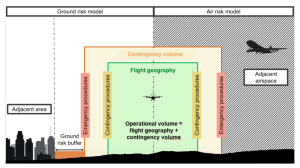FAQs
SORA stands for Specific Operations Risk Assessment. It’s a framework used to evaluate and mitigate risks associated with complex drone operations.
The purpose of a SORA is to systematically assess the risks involved in a drone operation and determine the necessary mitigations to ensure the safety of the operation for both the public and the airspace. The (SORA) provides guidance to both regulators and operators as to what is required for an required to fly an unmanned aircraft in a given operational environment.
SORA is specifically tailored for unmanned aircraft operations and provides a comprehensive, standardised approach that addresses both air and ground risks. Unlike general risk assessments, SORA is designed to meet the specific requirements of aviation regulators.
The SORA framework was developed by the Joint Authorities for Rulemaking on Unmanned Systems (JARUS), an international group that creates guidelines for the certification and operation of unmanned systems.
SORA is typically required for advanced and complex drone operations, such as Beyond Visual Line of Sight (BVLOS) flights, operations in controlled airspace, and any missions involving higher levels of risk.
Regulatory authorities use the SORA framework to evaluate the safety of drone operations, ensuring that operators have adequately assessed and mitigated risks before granting operational approval.
Creating a SORA is a 10 step process that involves:
- Concept Of Operations (CONOPS) description
- Determination of intrinsic Ground Risk Class (GRC)
- Determination of final Ground Risk Class (GRC)
- Determination of the initial Air Risk Class (ARC)
- Apply strategic mitigations to determine residual Air Risk Class (ARC)
- Apply tactical mitigations
- Determine the Specific Assurance and Integrity Level (SAIL) score
- Identify Operational Safety Objectives (OSOs)
- Considerations of adjacent area and airspace
- Comprehensive safety portfolio
The first step of the SORA requires the applicant to collect and provide the relevant technical, operational and system information needed to assess the risk associated with the intended operation. Required information includes:
- Task description
- Operational area
- Aircraft make and model
- Maximum Take-off Weight (MTOW)
- Any onboard safety systems
- Any payloads
- Ground Control Station (GCS)
- C2 link details
- Range
- Endurance
- Flight Profiles
- Additional equipment
Determining the Ground Risk Class is split into two steps. The first step is determining the intrinsic GRC. The intrinsic ground risk relates to the risk of a person being struck by the aircraft and considers the size of the aircraft as well as the population density below the operation.
The intrinsic ground risk can be controlled and reduced through mitigations, depending on the mitigations applied the final GRC is calculated.
Determining the Air Risk Class is split into three steps. The first step is to determine the aggregated collision risk category. This category is based on airspace characteristics such as altitude, controlled/uncontrolled airspace, airport proximity and airspace designation.
The residual ARC can be calculated by applying strategic mitigations and following that tactical mitigations are applied to mitigate any residual risk of a mid-air collision that is required to achieve the relevant safety objective.
The SAIL parameter consolidates the ground and air risk analyses and drives the required activities. The SAIL represents the level of confidence that the operation will stay under control.
The SAIL is used to evaluate the defences within the operation in the form of operational safety objectives (OSO) and to determine the associated level of robustness. The SORA methodology details OSOs that are option or recommended and the associated level of robustness along with the threat they help to mitigate.

